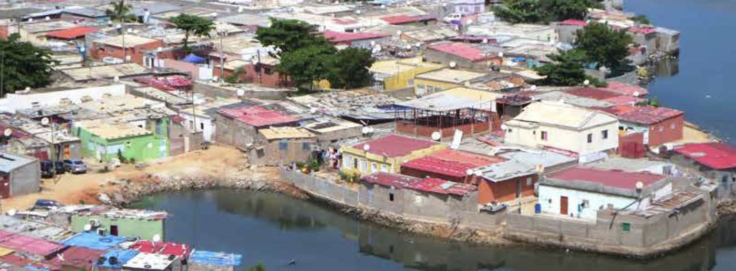
Search
Angola: The First Country in Africa to Develop a Municipal Multidimensional Poverty Index

Located on the western coast of south-central Africa, the Republic of Angola has a population of approximately 31 million (2020). According to the 2019 global Multidimensional Poverty Index (MPI), 51% of its population lives in multidimensional poverty.
The Angolan National Institute of Statistics (INE), together with the United Nations Development Programme (UNDP) in Angola and the Oxford Poverty and Human Development Initiative (OPHI), has been working on the development of a national MPI. As a first step, INE officially presented the first edition of the Municipal Multidimensional Poverty Index Report (M-MPI) in December 2019.
Angola’s M-MPI complements monetary poverty indexes and allows for the identification of those who experience multiple deprivations simultaneously in terms of health, education, quality of housing, and employment for each one of the 164 municipalities in the country.This index was calculated using data from the General Population and Housing Census (2014), because it is the only source of information that is able to capture the nature of multidimensional poverty at a municipal level.
The M-MPI’s objective is to identify the level of poverty of each municipality and group them into technically sound and useful classifications. These classifications can then be used to prioritise public budget distributions to municipalities according to their deprivations as well as to assist in the design and development of public policies aimed at fulfilling national, regional, and international commitments (such as the National Development Plan 2018–2022, Agenda 2063, and the 2030 Agenda, respectively).
65 of the 164 municipalities have an incidence of poverty of over 90% – in other words, at least nine out of ten people in these municipalities are multidimensionally poor.
The M-MPI is composed of four dimensions (health, education, quality of housing, and employment) and 11 indicators, which were selected based on the results of technical meetings and public consultations with different sectors of society. This measure uses the same weighting for each dimension and the same relative weighting for each indicator. The dimensions of education, quality of housing, and employment have three indicators each (civil registry, years of schooling, and school attendance; solid fuel for cooking, access to electricity, and type of materials used for the construction of walls, floor, and roof; youth unemployment, unemployment among adults, and dependency), each with a weight of 8.33%. The dimension of health has only two indicators (access to drinking water and access to sanitation), and each of them has an equal weight of 12.5%.
The multidimensional poverty line was set at 35% of the weighted indicators. This multidimensional poverty line corresponds with a situation in which a person or household experiences deprivations equivalent to one dimension plus one indicator with an average weighting.
The results of the municipal estimates for the M-MPI, as well as the incidence and intensity of poverty, show that 65 of the 164 municipalities have an incidence of poverty of over 90% – in other words, at least nine out of ten people in these municipalities are multidimensionally poor.The M-MPI varies from 0.029 in the municipality of the country’s capital city (Luanda) to 0.753 in the municipality of Curoca in the Province of Cunene, located in the south of the country. Figure 1 shows the value of the M-MPI for each municipality of Angola.

The results showed important differences in the contribution of each of the 11 indicators to multidimensional poverty in each municipality. In the municipalities with a higher M-MPI, it is clear that the dimensions of health and quality of housing contribute much more. In the municipalities with lower M-MPI levels, there is a significant contribution from indicators related to the dimension of employment.
Given that the main objective of the M-MPI is to classify municipalities according to their level of poverty in order to prioritise the poorest, three classifications of municipalities in Angola were proposed based on these results.
- The first classification consists of grouping municipalities according to their levels of multidimensional poverty in quintiles (five groups of approximately 33 municipalities each) based on a single criterion: the level of multidimensional poverty.
- The second classification consists of maintain- ing the order by quintiles and prioritising, within each quintile, the municipalities with the highest proportion of multidimensionally poor according to the total population of the municipality.
- The third proposal is to use information about the level of multidimensional poverty and the total multidimensionally poor population while taking into account the size of the municipality’s population. To this end, the 164 municipalities were organised into three groups:
- Large municipalities (more than 500,000 inhabitants);
- Medium-sized municipalities (between 50,000 and 500,000 inhabitants);
- Small municipalities (less than 50,000 inhabitants).
In this proposal, the levels of poverty and total number of poor in the municipality are decisive factors in the prioritisation of municipalities within each group.
INE and UNDP hope that the results of this re- port will support:
- Integrated evidence-based decision-making,
- Improvement in social services at a local level,
- Dialogue and decisions about the distribution of the General State Budget,
- Reflection on inequalities between municipalities, » Reflection on social projections related to population growth,
- Prioritisation, monitoring, and evaluation of public policies.
During 2020, INE, UNDP, and OPHI will work towards the development and publication of a national Multidimensional Poverty Index for Angola (MPI-N) with specific indicators for Angola, with the aim of complementing the global MPI. It is hoped that the partnership between the three institutions can contribute to dialogue and the adoption of evidence-based policies to end poverty in all its dimensions, reduce inequalities, and leave no one behind.

This article was published in Dimensions 9
















